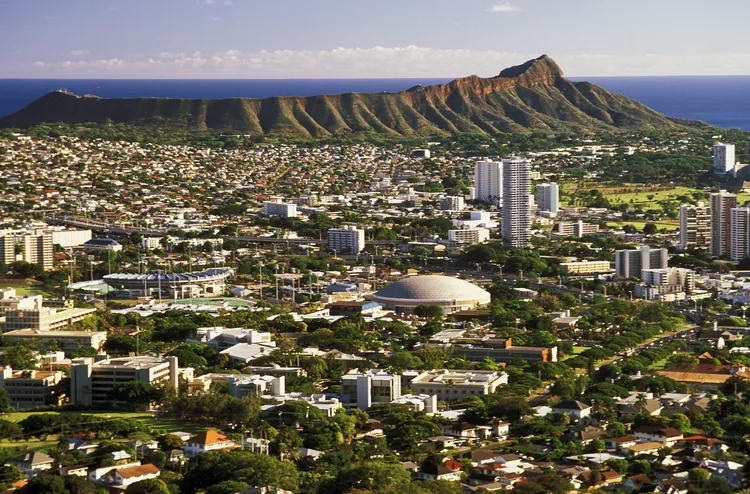Summary
Oahu’s Manoa Valley, although located within minutes of Waikiki by bus or car, is often totally overlooked by visitors. While the lack of heavy visitor traffic is surely appreciated by local residents, there is much to be appreciated in this secluded corner of Hawaii which makes a visit worthwhile.
University of Hawaii, Manoa Campus
Founded in 1917, the University of Hawaii at Manoa is the flagship of the University of Hawaii System, the state’s sole public university system with campuses on each of the main islands. Today more than 19,800 students are enrolled in Manoa courses. Manoa offers 87 bachelor’s degrees, 87 master’s degrees, and 53 doctorates.
Moreover, Manoa is the most diverse campus in the United States, with 57% of the student body being of Asian or Pacific Islander ancestry. The University is renowned for its Asian, Pacific, and Hawaiian studies as well as its programs in tropical agriculture, tropical medicine, oceanography, astronomy, electrical engineering, volcanology, evolutionary biology, comparative philosophy, urban planning, and international trade.
The beauty of the Manoa valley provides a backdrop for this unique, yet inviting, campus. Hawaiian, Asian, and Pacific traditions are well represented throughout the campus. There is an authentic Japanese tea house and garden, a replica of a Korean king’s throne hall, and a Hawaiian taro patch.
Manoa Marketplace Shopping Center
Manoa Marketplace offers a wide variety of specialty shops, restaurants, island foods, a supermarket, and a drugstore. It is the primary shopping location for valley residents, many of whom gather at the Manoa Cafe for coffee and local baked goods. Consequently, it’s the perfect place for a brief snack stop before you venture further into the Manoa Valley.
Manoa Chinese Cemetery
The Manoa Chinese Cemetery is the oldest and largest Chinese cemetery in Hawaii. Starting in 1852, the Chinese community gradually began to purchase the land from the former landowners, which included the Bishop Estate. The present-day cemetery encompasses thirty-four acres of Manoa Valley.
The Chinese immigrant, Lum Ching, who first identified the site in 1852, founded a society called Lin Yee Chung, which means “We are buried together here with pride.” The United Chinese Society was formed in 1884 to handle the management of the cemetery.
In 1889, the land was granted in perpetuity to the society by charter from Hawaii’s Minister of Interior, L.A. Thurston. Poor management over the years almost doomed the cemetery; however, it was rescued by three men—Wat Kung, Chun Hoon, and Luke Chan—who organized the plots, improved the overall condition of the cemetery, and fought a long battle with local residents who wanted to abolish the cemetery.
Today, the cemetery is operated solely by the Lin Yee Chung Association. Within the cemetery, you will find numbered signs identifying notable areas of interest.
Lyon Arboretum
The Lyon Arboretum was established in 1918 by the Hawaiian Sugar Planters Association to demonstrate the value of watershed restoration, test tree species for reforestation, and collect plants of economic value.
Moreover, in 1953, it became part of the University of Hawaii. Today, Lyon Arboretum continues to develop its extensive tropical plant collection, emphasizing native Hawaiian species, tropical palms, aroids, ti, taro, heliconia, and ginger.
After the University took over, the emphasis shifted from forestry to horticulture. During the last thirty years, nearly 2,000 ornamental and economically useful plants have been introduced to the grounds. More recently, the arboretum has dedicated itself to becoming a center for the rescue and propagation of rare and endangered native Hawaiian plants.
Manoa Falls
At the end of Manoa Road is a parking area for the hiking trail to Manoa Falls. While classified as an “easy” .8 mile, two-hour round-trip, the hike is anything but easy following heavy rains or for anyone who is not in shape. The trail meanders through a bamboo forest, rainforest, and base of the Ko’oaus Mountains. It is very rocky in places; in other places, there are wooden or concrete steps to assist you.
The path parallels the Manoa Stream, whose water is heavily polluted with leptospirosis bacteria. Therefore, do not drink or swim in the water. Additionally, there are plenty of mosquitoes and other biting insects, so a good application of bug spray is a must.
At the end of the path, you will find the 150-foot Manoa Falls, whose flow ranges from spectacular following heavy rains to mildly impressive on most days. Again, do not be tempted to swim in the water due to the severe danger of falling rocks close to the falls.





